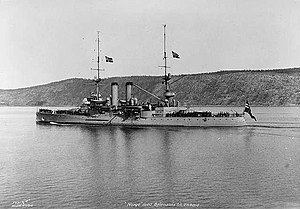HNoMS Norge

Norge transporting the coffin of writer Bjørnstjerne Bjørnson in 1910
|
|
| History | |
|---|---|
|
|
|
| Name: | Norge |
| Namesake: | Norway |
| Builder: | Armstrong Whitworth at Newcastle on Tyne |
| Launched: | March 1900 |
| Commissioned: | 7 February 1901 |
| Fate: | Sunk 9 April 1940 in Narvik Harbour, Norway |
| General characteristics | |
| Class and type: | Eidsvold class |
| Displacement: | 4,233 tons (standard) |
| Length: | 94.60 m (310.37 ft) |
| Beam: | 15.70 m (51.51 ft) |
| Draft: | 5.40 m (17.72 ft) |
| Propulsion: |
|
| Speed: | 17.2 knots (31.85 km/h) |
| Complement: | 270 fully crewed, reduced to 229 in 1940, just 191 aboard when sunk |
| Armament: |
|
| Aircraft carried: | none |
HNoMS Norge was a coastal defence ship of the Eidsvold-class in the Royal Norwegian Navy. Built by Armstrong Whitworth at Newcastle on Tyne, she was torpedoed and sunk by German destroyers in Narvik harbour on 9 April 1940.
Built as part of the general rearmament in the time leading up to the events in 1905, Norge remained, along with her sister-ship Eidsvold, the backbone of the Royal Norwegian Navy for just over 40 years. Norge and Eidsvold were the largest vessels in the Royal Norwegian Navy, displacing 4,233 tons and crewed by 270 men. Both vessels were considered to be quite powerful for their time, with two 21 cm (8.26 inch) guns as their main armament. They were armoured to withstand battle with ships of a similar size, with 6 inches (15.24 cm) of Krupp cemented armour in the belt and 9 inches (22.86 cm) of the same armour on the two gun turrets.
It was intended to augment the Norwegian coastal defence ship fleet with the two ships of the Bjørgvin class, ordered in 1912, but after these were requisitioned by the British Royal Navy while still under construction at the outbreak of World War I the Eidsvold class and the older, two ship strong, Tordenskjold class was forced to soldier on long after they were obsolete.
On the morning of 9 April 1940, German forces entered Ofotfjord under cover of fog and heavy snow. The Germans contacted the captain of Eidsvold, demanding that he surrender, and when this was turned down, the battle-ready German destroyers torpedoed Eidsvold before she could fire her guns.
...
Wikipedia
